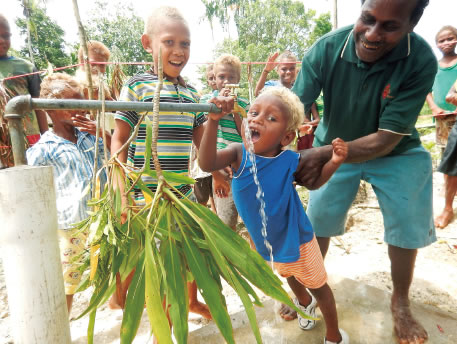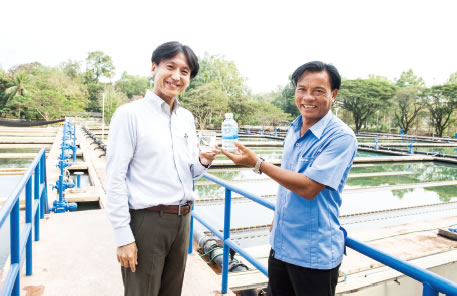(2) Safe Water and Sanitation
Water and sanitation are vital issues linked to human life. In 2015, approximately 663 million people worldwide had no access to safe water, such as piped water and wells, and approximately 2.4 billion people—about a half of the population of developing countries—had no access to improved sanitation facilities, such as toilets and sewage systems. (Note 15) Diarrhea due to lack of safe water and sanitation facilities accounts for 9% of the causes of under-five deaths. (Note 16) Moreover, being unable to access safe water hobbles the economy. For example, in developing countries where piped water is not widely available, in many cases women and children bear the role of fetching water. Sometimes they spend many hours going to draw the water, so opportunities for the education of the children and the empowerment of the women are being lost. Furthermore, an unstable supply of water has a negative impact on healthcare and agriculture as well.
From this viewpoint, in the 2030 Agenda, “Ensure availability and sustainable management of water and sanitation for all” is set under Goal 6.
<Japan’s Efforts>

Children drink water from the first water supply facility constructed by aid from Japan in Kolofe village in the northern area of the Malaita Province in Solomon. (Photo: Koji Yamaguchi / Embassy of Japan in Solomon)
Japan’s assistance for the fields of water and sanitation is the largest in the world. Japan provides comprehensive support that is both soft (non-physical) and hard (physical) by drawing on Japan’s extensive knowledge, experience, and technology in these fields, including: (i) promotion of integrated water resources management; (ii) provision of safe drinking water and basic sanitation (improvement of sanitation facilities); (iii) support to enable water use for increasing food production and other purposes (e.g., water for agricultural use); (iv) water pollution prevention (establishing effluent regulations) and ecosystem conservation (conservation of vegetation and sustainable forest management); and (v) mitigation of damage from water-related disasters (establishment of an early warning system and strengthening the disaster response capacities of communities).
Through its development cooperation, Japan supports wider expansion of safe water in developing countries with technical cooperation such as the dispatch of experts and acceptance of trainees from developing countries, ODA loans and grant aid. In addition, Japan is providing support through international organizations.
For example, in the Asia and Oceania region, Japan is currently implementing projects for the development and expansion of piped water in Myanmar, Cambodia, Viet Nam, and Palau. In Laos, a new ODA loan for the Vientiane Capital Water Supply Expansion Project was signed in March 2016. In India, where the population is increasing and economic development is progressing, a new ODA loan for the Odisha Integrated Sanitation Improvement Project was signed in March, 2016.
In Africa, Japan is currently implementing projects aimed at improving access to safe water and the water supply ratio in Ethiopia, Senegal, Rwanda, etc. Regarding Sudan, new grant aid for the Project for Improvement of Water Treatment Plant in Kosti City was signed in October 2016.

A Japanese expert works to improve the technology for safe and stable urban water supply in Vientiane, Laos. A JICA expert, Mr. Yusuke Kinoshita (left), and the plant director who holds a bottle of mineral water produced with purified water from the Chinaimo Water Treatment Plant which was constructed in 1996 by grant aid from Japan. (Photo: Shinichi Kuno / JICA)
In addition, Japan supports the water and hygiene environment improvement projects by Japanese NGOs through the Grant Assistance for Japanese NGO Projects.
For example, for one year from FY2015 the HOPE International Development Agency in Japan, a specified non-profit corporation, installed water supply systems and public toilets in schools and clinics in five villages in the Tsayte District of Ethiopia, established operation and management systems, and provided human resources development in health and hygiene education so that the residents could secure access to safe water in the long term.
In parallel with these efforts, cooperation using Grant Assistance for Grass-Roots Human Security, etc. and efforts for the improvement of the water environment of developing countries in cooperation with domestic and local private sector organizations are also being carried out in regions around the world.
The Ministry of the Environment is also carrying out initiatives. For example, there are serious water contamination problems in many Asian countries. In order to eliminate the lack of relevant information and knowledge the Ministry started the Water Environment Partnership in Asia (WEPA). With the cooperation of the 13 participating countries (Note 17) in Asia, it is aiming to enhance water environment governance in Asia through the building of human networks, the gathering and sharing of information, and capacity building, etc.
- Note 15: Source WHO/UNICEF “Progress on Sanitation and Drinking-Water: 2015 Update and MDG Assessment”
- Note 16: Source UNICEF “Committing to Child Survival: A Promise Renewed” (Progress Report 2015)
- Note 17: Japan, Cambodia, Thailand, Laos, Malaysia, China, Indonesia, the Republic of Korea, the Philippines, Viet Nam, Myanmar, Sri Lanka, and Nepal
•Democratic Republic of the Congo
The Project to Install the Water Treatment Unit / N’djili Kilambu de la Commune de Mont Ngafula
Grant assistance for grassroots human security projects (February 2015 – July 2016)

Project participants gather in front of an installed water treatment unit. (Photo: Embassy of Japan in the Democratic Republic of the Congo)
In the Democratic Republic of the Congo, society and economy have become impoverished due to long-term foreign and domestic conflicts, so the urgent issues are the efforts for improved access to social services and economic development.
The water supply ratio in the Democratic Republic of the Congo before implementation of this project was no more than about 46%, and even in the capital Kinshasa the scope of supply by the public water supply authority was limited to the central parts of the city. In regions with underdeveloped water supply facilities, infectious diseases such as cholera and others caused by the use of unsanitary water have become a problem because residents had no choice but to drink water from rivers or go to draw water from a spring located several kilometers away.
In order to alleviate these serious water problems in the region, the NGO “Coup de Pouce” obtained the assistance of Yamaha Motor Co., Ltd. and asked Japan to support implementation of a water treatment unit development project using the grant assistance for grassroots human security projects.
When general rapid filtration equipment is used, replacement of filters and expert knowledge of maintenance are required. Accordingly, its management by the villagers is thought to be difficult. Meanwhile, the water treatment units made by Yamaha Motor Co., Ltd., installed in this project can be operated, managed and maintained by the recipient organization and local residents because special chemicals or replacement of filters are not required.
In July 2016, the handover ceremony of the water treatment units was held after completion of the installation work. The new water treatment units have enabled the supply of approximately 8,000 liters of drinking water per day and have allowed approximately 13,000 residents in the region to get access to safe drinking water.
